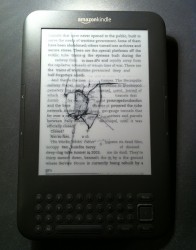Amazon’s second missed opportunity
 So yesterday I posted about how Amazon missed an opportunity to get ahead of their competition. They could have developed an improved version of the Kindle file format back before the Kindle launched and released it with the new gadget.
So yesterday I posted about how Amazon missed an opportunity to get ahead of their competition. They could have developed an improved version of the Kindle file format back before the Kindle launched and released it with the new gadget.
As I was writing a footnote to that post, I thought of a second opportunity that Amazon passed on: apps.
Amazon launched the Kindle in November 2007 as a stand alone 6″ ereader. There was no other part of the platform; in particular there were no apps. The Kindle didn’t get its first app until almost 18 months later, in early 2009. But if Amazon had wanted to have an app, they could.
I’ve said elsewhere that the Kindle and Mobipocket files are virtually identical. The main difference is that the Kindle file has a few extra bits of DRM, and anyone who has worked with the format will know this is true. Also, a couple months ago I posted proof that Kindle4PC shared code with an old Mobipocket app. Plus I’ve been told that some of the software running on the Kindle is also running inside the Bookeen Cybook Gen3, an ereader that read Mobipocket files.
That’s why I believe that with a small amount of work Amazon could have released a modified version of Mobipocket Desktop, a PC app, alongside the Kindle. And even if it took a lot of work, they still should have done it.
Do you recall the stretches of 2007 and 2008 when you couldn’t buy a Kindle to save your life? If this app had been available people would have downloaded it and bought ebooks. Think of how many sales Amazon lost because there was no way to buy ebooks.
I don’t know how big an affect this one app would have had, but I do know that it could only have helped. My guess is that Amazon’s customer base would have been a minimum of 5 to 10 times larger on launch day. Think about it. Everyone who was frustrated by the lack of a Kindle would have downloaded the app. Everyone who was even slightly curious about the Kindle would have downloaded the app. This would get Amazon what it wanted all along – lots of people buying ebooks.
Amazon don’t really want to sell hardware; they want to sell ebooks. That’s where the long term money is, and that’s why they eventually released apps.
P.S. What’s most interesting about this is that back before the Kindle launched, Amazon actually used this app to support the Kindle. If you ran MobiDesktop and then plugged in your Kindle to USB, the app recognized that you had attached a valid device and offered to transfer files over. Unfortunately this only worked with MobiDesktop v6.0, and Amazon took the feature away when v6.1 was released.
image by Chris Walters of BookSprung

Comments
GaryG April 22, 2011 um 9:11 am
I’m not so sure. I have no interest in reading ebooks on anything other than an e-ink screen. I, and apparently many others, jumped into the ebook market with the introduction of the Kindle 3 because of its upgrade in screen quality and downgrade in price. With that device, ebooks came of age, and now I’m thoroughly hooked. If I had to choose between e-ink and paper, I’d actually choose the former. But if I had to choose between a smartphone or PC app and paper, I’d choose the latter.
Liz April 22, 2011 um 3:43 pm
But Gary, the .mobi format is HORRIBLE. The main screen and browsing menu on the Kindle is hard to read and confusing. As an author that publishes directly to the digital marketplace, I’m severely disappointed in the conversion process Amazon uses. Barnes & Noble’s PubIt program actually renders my book as I want it to look. Call me a perfectionist, but I would rather my book look nice than conform to an unnecessary document format. I know that most people aren’t interested in no-name or lesser-known authors, but if you ever buy a self-published ebook from Amazon you’re going to end up with funky characters, irregular alignment, and other issues that will make your reading experience more stressful than its worth.
Sweetpea April 22, 2011 um 4:42 pm
A pure desktop app would not have made much of a difference, I think. Back in 2007, the smartphones were only just starting and had tiny screens (at least, compared to the 6″ the Kindle has). And reading behind a pc never was a real substitute for reading paper books…